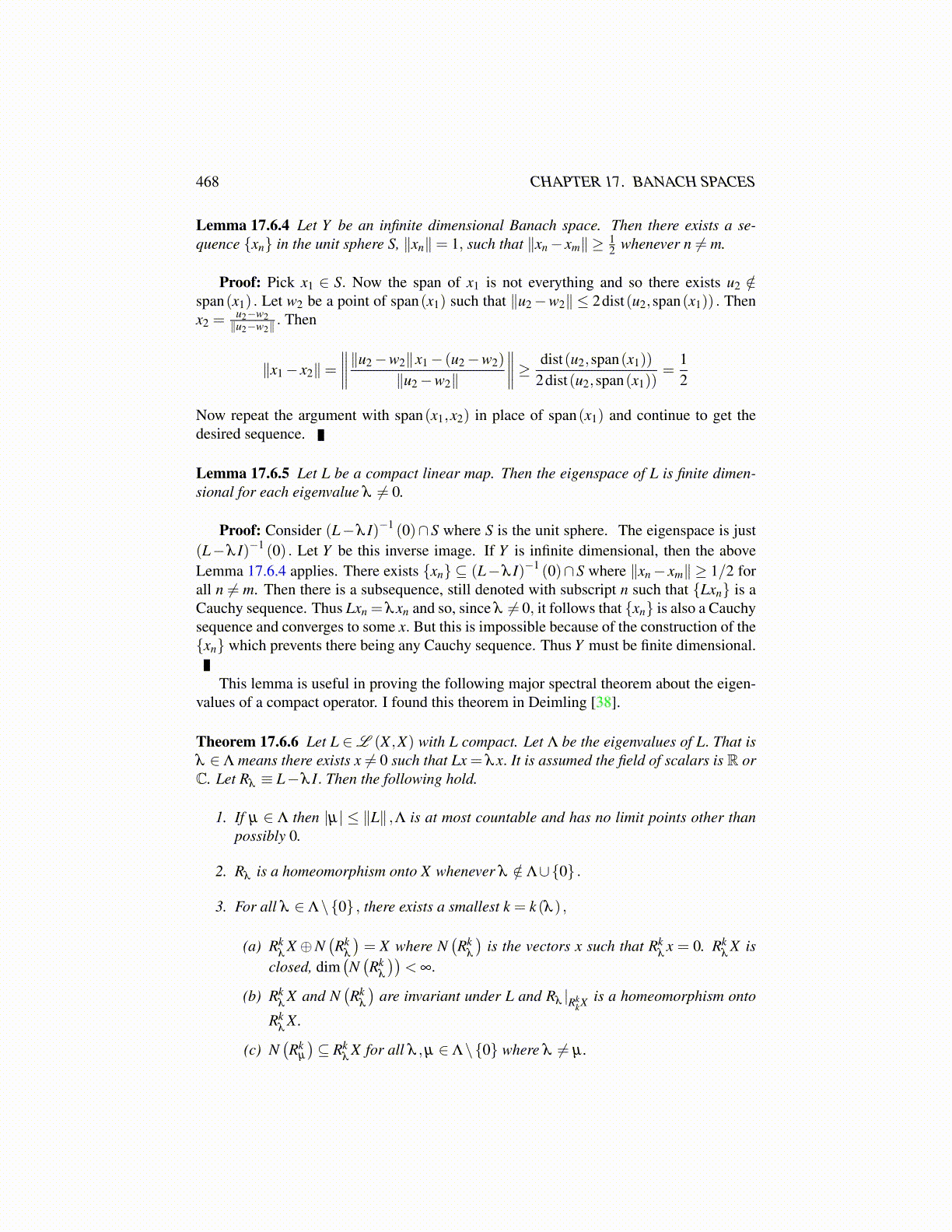
468 CHAPTER 17. BANACH SPACES
Lemma 17.6.4 Let Y be an infinite dimensional Banach space. Then there exists a se-quence {xn} in the unit sphere S, ∥xn∥= 1, such that ∥xn− xm∥ ≥ 1
2 whenever n ̸= m.
Proof: Pick x1 ∈ S. Now the span of x1 is not everything and so there exists u2 /∈span(x1) . Let w2 be a point of span(x1) such that ∥u2−w2∥ ≤ 2dist(u2,span(x1)) . Thenx2 =
u2−w2∥u2−w2∥
. Then
∥x1− x2∥=∥∥∥∥∥u2−w2∥x1− (u2−w2)
∥u2−w2∥
∥∥∥∥≥ dist(u2,span(x1))
2dist(u2,span(x1))=
12
Now repeat the argument with span(x1,x2) in place of span(x1) and continue to get thedesired sequence.
Lemma 17.6.5 Let L be a compact linear map. Then the eigenspace of L is finite dimen-sional for each eigenvalue λ ̸= 0.
Proof: Consider (L−λ I)−1 (0)∩S where S is the unit sphere. The eigenspace is just(L−λ I)−1 (0) . Let Y be this inverse image. If Y is infinite dimensional, then the aboveLemma 17.6.4 applies. There exists {xn} ⊆ (L−λ I)−1 (0)∩S where ∥xn− xm∥ ≥ 1/2 forall n ̸= m. Then there is a subsequence, still denoted with subscript n such that {Lxn} is aCauchy sequence. Thus Lxn = λxn and so, since λ ̸= 0, it follows that {xn} is also a Cauchysequence and converges to some x. But this is impossible because of the construction of the{xn} which prevents there being any Cauchy sequence. Thus Y must be finite dimensional.
This lemma is useful in proving the following major spectral theorem about the eigen-values of a compact operator. I found this theorem in Deimling [38].
Theorem 17.6.6 Let L ∈L (X ,X) with L compact. Let Λ be the eigenvalues of L. That isλ ∈ Λ means there exists x ̸= 0 such that Lx = λx. It is assumed the field of scalars is R orC. Let Rλ ≡ L−λ I. Then the following hold.
1. If µ ∈ Λ then |µ| ≤ ∥L∥ ,Λ is at most countable and has no limit points other thanpossibly 0.
2. Rλ is a homeomorphism onto X whenever λ /∈ Λ∪{0} .
3. For all λ ∈ Λ\{0} , there exists a smallest k = k (λ ) ,
(a) Rkλ
X ⊕N(Rk
λ
)= X where N
(Rk
λ
)is the vectors x such that Rk
λx = 0. Rk
λX is
closed, dim(N(Rk
λ
))< ∞.
(b) Rkλ
X and N(Rk
λ
)are invariant under L and Rλ |Rk
kX is a homeomorphism onto
Rkλ
X.
(c) N(Rk
µ
)⊆ Rk
λX for all λ ,µ ∈ Λ\{0} where λ ̸= µ .